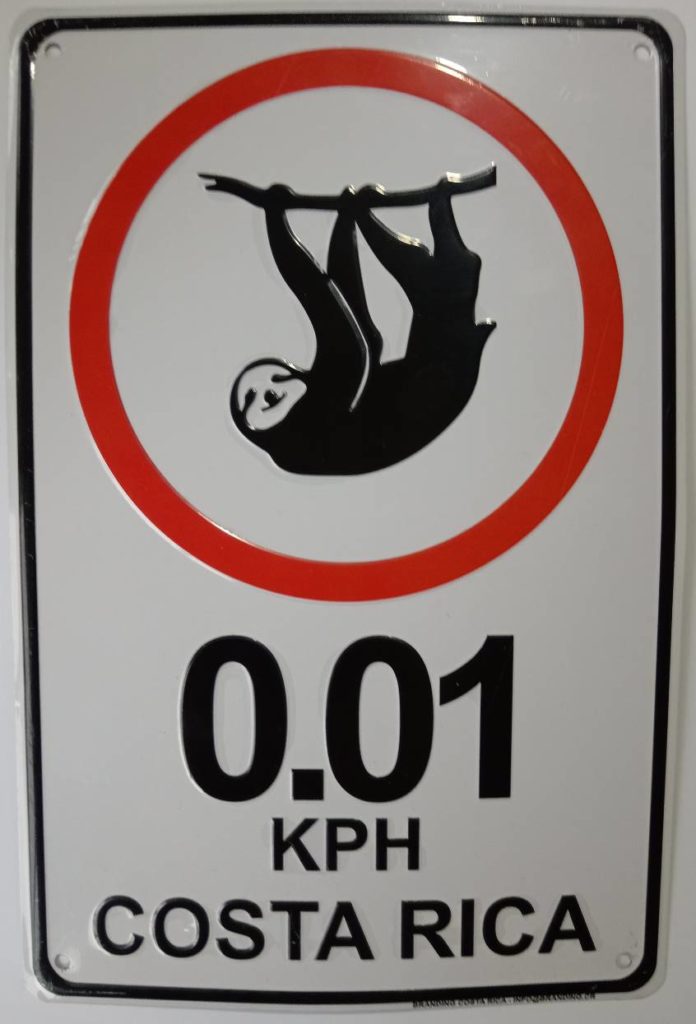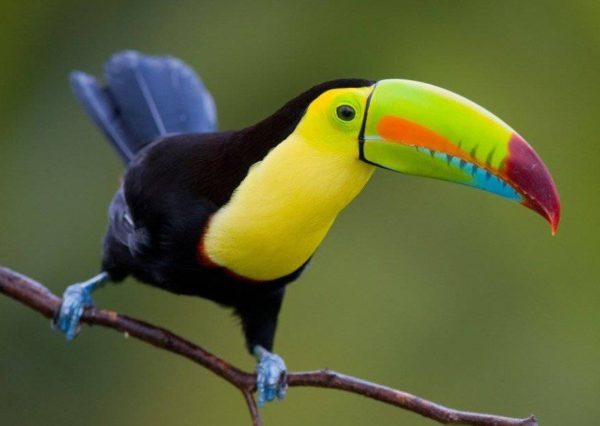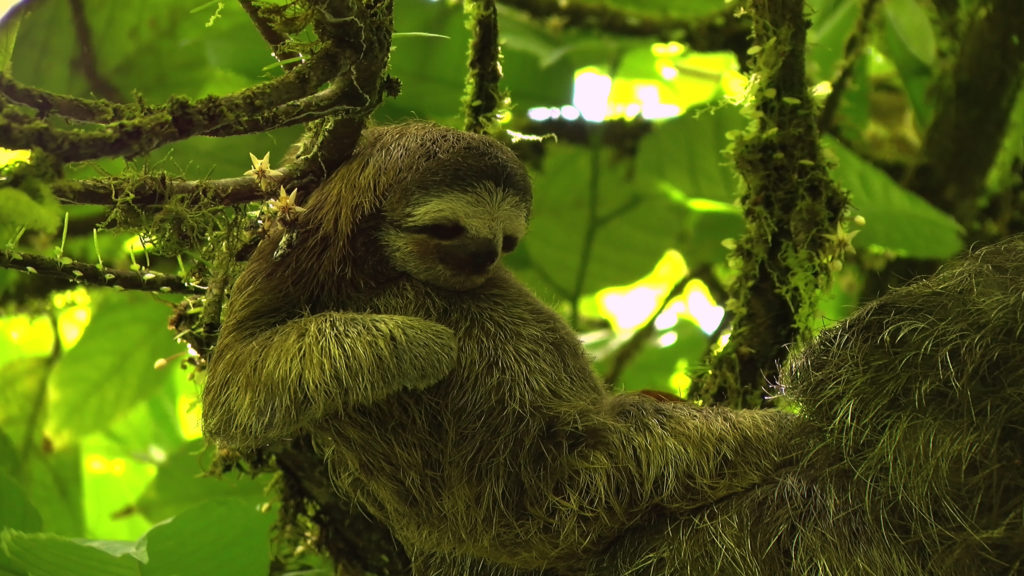By Steven Greenleaf
A few meters outside our learning center is a row of trees. Below them is a creek full of wildlife. On the other side of them is a small road and another line of trees which leads to another small creek. This line of trees is a highway for our local monkeys and squirrels, and a very low-speed highway for our local Two-toed Sloths. This narrow trail through the trees allows our friends to move between these two creeks and the lovely forests that grow along their banks. At its narrowest point this trail is only two trees wide. Those trees are very important. Without them the animals would not be able to use both areas.
I am an experienced land manager and I nearly cut them down.
When we first started developing this land I selectively cut some trees both to reduce overcrowding and to create some views. It’s mostly luck that I didn’t sever the pathway in the sky. I didn’t know how important that little spot was. What if I had cut them and the boy sloth and girl sloth had ended up permanently separated? Now, after years of being observant, we know where our four legged neighbors like to cruise. We guard their pathways diligently. Being a good steward of the environment isn’t always easy. There’s a lot to know and the best course is not always obvious.

Environmental and sustainability studies are like that. Usually complex and not always obvious. Last month’s article (Part One) talked about art, creativity, and the environment. We read that art and creativity when fused with environmental science can raise awareness, change behavior, promote equity and help innovate applied solutions to environmental problems.
We as educators face a challenge and an opportunity here. “Creativity often appears in the curricula of arts, science, technology and languages, but seldom in that of environmental studies or sustainable development.” (Vivian M.Y. Chang). Reviews have shown that creativity has not become an important part of environmental and sustainability studies in schools and universities.
While at university I was lucky to be able to go into the field with two great professors, Arnold Schultz and Hans Jenny. Arnold was a founder of Conservation and Natural Resources at Berkeley. He coined the term ‘Ecosystemology,’ and taught the world’s first course on the subject. Hans wrote one of the books that formed the foundations of modern soil science. Magic happened when these two old guys found an unusual soil profile or a pygmy cypress. They became young before our eyes.
In Mendocino County on the Northern California Coast is a small, unique ecosystem called the Pygmy Forest. Trees that normally grow to great size are so small in the Pygmy Forest you can step right over them. No one could figure out what caused this.
Hans and Arnold figured out that this a very, very old ecosystem wherein little had changed for millions of years. Without real disturbances the soil formed into a hardpan with very low nutrients that stunted the trees. Because of Arnold and Hans and others the Pygmy Forest is now protected.
They created a model of how ecosystems form and function they called the “CLORPT…..” equation. Climate + Organisms + Relief (Topography) + Parent Material (the bedrock that forms the soil) + Time. Notice the dots at the end of the equation. Arnold always stressed those dots as places where you could add to the equation, you could be creative. I still use this all the time. It is a cognitive, heuristic model that helps me analyze and understand what I see in nature. Most importantly, Hans and Arnold planted seeds in my thoughts that how I was looking at things could be as important as what I was looking at. They got me thinking about mental models.
Critical Creativity is a process, ”which promotes using cognitive critique and creative imagination to deconstruct, reconstruct and transform prevailing practices and knowledge.” (Brodin & Frick, 2011). It is a blending of art, science, ethics, divergent thinking, creative problem solving, cognitive analysis, and creative imagination. Critical creativity requires a new definition of creativity.
“Educators should define creativity …..as thinking or problem solving that involves the construction of new meaning. This in turn relies on personal interpretations, and these are personal and new for the individual, not on any larger scale. This approach is consistent with the educational premise ‘to understand is to invent’, and it allows educators to target self-expression. The emphasis is thus on the individual, the self. Creativity is, then, something we can find in every child, not just the gifted or highly intelligent.” (Mark Runco) I like that Runco agrees with Sir Ken that every child is creative.
“It is the overwhelming tendency for teachers to tell students what to learn as opposed to teaching them how to learn.” I agree with Nathan Hensley that it’s best to teach, “…students how to learn rather than what to learn, emphasizing the need to cultivate contemplation and creativity, and exploring the opportunities associated with divergent thinking. (N. Hensley, 2020). It’s impossible to teach what to learn in complex environmental problems – there’s usually no way to anticipate all, or even the majority of the variables. You have to assess and adapt.
We just hosted an interdisciplinary group of undergraduate students from Auburn University. I was able to try out something new with them and it surpassed all my expectations. Don’t you love it when you try something in education and that happens?
I did a presentation and discussion with them where for the first time I blended part of Sir Ken Robinson’s Finding Your Element practices with our own central effort of pointing out skill areas that are crucial for environmental success and that are often overlooked. It was a discussion of analyzing one’s own aptitudes and passions (internal) while looking for better ways to analyze environmental problems (external). Creativity swooped in like a toucan bearing its magic and we discovered something valuable and worth pursuing.

I know now that in environmental and sustainability studies we must break the imaginary boundary between the critical and the creative. Nathan Hensley looks at mindfulness and education for sustainable development. He says that using mindfulness to convert discomfort into inquiry can transform approaches to even the most difficult environmental problems. Here again we are erasing the external / internal boundary.
”Promoting creativity through mindfulness allows one to leverage cognitive dissonance as a means to becoming grounded for new discoveries and making new connections.” (Nathan Hensley, 2020)
The Auburn students were an admirable group of young people; very interdisciplinary, and with common interests in how the world can work, how it can be protected, and how things can be better. For a young undergrad, lack of experience and generalized knowledge are going to be obstacles to solving complex sustainability problems that cross disciplines. It’s not realistic to expect them to have the acumen straight out of exams. They need to know how to think, how to ask questions, and then have pathways to get their questions answered i.e. mentors, colleagues, networks. They need to know how to assess themselves – their aptitudes, skills, and passions. Blending creativity and critical skills seems to me to be the best way forward to assessing environmental problems and themselves in relation to finding solutions. We cannot afford to let these people falter. We need them to create a better future.
“The understanding and creative visualization of today’s problems and tomorrow’s possibilities is, I believe, a prerequisite for hope. (Maria Ojala, 2016)
Soon they’ll be out of school and building the next chapters of their lives. As they make this part of the transition to their professions, our mission is to help them learn how to think, including about themselves – to help them find their Element. The boundary between the critical and the creative is a myth. Our pedagogies need to evolve to reflect this. I believe Sir Ken Robinson would agree.
Thanks for your attention.
Developing individual creativity for environmental sustainability: Using an everyday theme in higher education. Vivian M.Y. Cheng. Thinking Skills and Creativity.Volume 33, September 2019.
Conceptualizing and encouraging critical creativity in doctoral education. Eva M. Brodin, Liezel Frick
International Journal for Researcher Development. 2011
Education for Creative Potential. Mark A. Runco. Published online. (2010) https://www.tandfonline.com/author/Runco%2C+Mark+A
Educating for sustainable development: Cultivating creativity through mindfulness. Nathan Hensley. Journal of Cleaner Production. Volume 243, 10 January 2020
Hope and anticipation in education for a sustainable future. Maria Ojala. Örebro University, Sweden. 2016
06 July 2025 Steven Greenleaf
